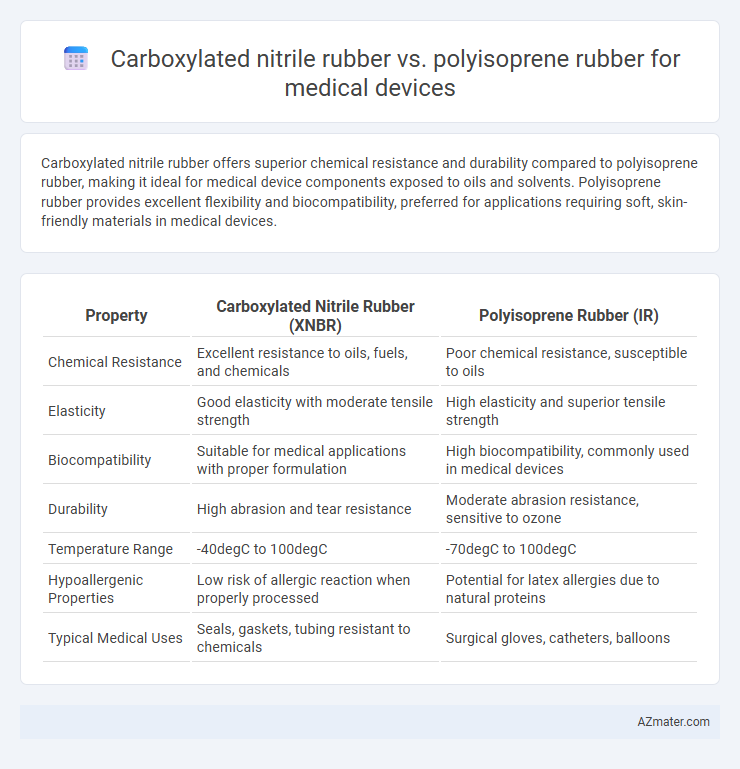Carboxylated nitrile rubber offers superior chemical resistance and durability compared to polyisoprene rubber, making it ideal for medical device components exposed to oils and solvents. Polyisoprene rubber provides excellent flexibility and biocompatibility, preferred for applications requiring soft, skin-friendly materials in medical devices.
Table of Comparison
| Property | Carboxylated Nitrile Rubber (XNBR) | Polyisoprene Rubber (IR) |
|---|---|---|
| Chemical Resistance | Excellent resistance to oils, fuels, and chemicals | Poor chemical resistance, susceptible to oils |
| Elasticity | Good elasticity with moderate tensile strength | High elasticity and superior tensile strength |
| Biocompatibility | Suitable for medical applications with proper formulation | High biocompatibility, commonly used in medical devices |
| Durability | High abrasion and tear resistance | Moderate abrasion resistance, sensitive to ozone |
| Temperature Range | -40degC to 100degC | -70degC to 100degC |
| Hypoallergenic Properties | Low risk of allergic reaction when properly processed | Potential for latex allergies due to natural proteins |
| Typical Medical Uses | Seals, gaskets, tubing resistant to chemicals | Surgical gloves, catheters, balloons |
Overview of Carboxylated Nitrile Rubber and Polyisoprene Rubber
Carboxylated nitrile rubber (XNBR) features enhanced abrasion resistance, chemical stability, and superior tensile strength due to the introduction of carboxyl groups, making it suitable for medical devices requiring durability and resistance to oils and chemicals. Polyisoprene rubber offers excellent elasticity, biocompatibility, and low allergenic potential, closely mimicking natural rubber's properties, which is ideal for gloves and other flexible medical applications. The choice between XNBR and polyisoprene depends on specific medical device requirements, balancing chemical resistance with tactile sensitivity and patient safety.
Chemical Structure and Composition Comparison
Carboxylated nitrile rubber (XNBR) features nitrile groups with added carboxyl groups, enhancing polarity and chemical resistance, which improves compatibility with polar substances in medical devices. Polyisoprene rubber, derived from natural or synthetic isoprene, has a non-polar hydrocarbon backbone with unsaturated double bonds, providing excellent elasticity but lower chemical resistance. The presence of carboxyl groups in XNBR leads to better resistance to oils and chemicals compared to the more hydrophobic and less chemically resistant structure of polyisoprene rubber.
Mechanical Properties for Medical Applications
Carboxylated nitrile rubber (XNBR) exhibits superior tensile strength, abrasion resistance, and chemical stability compared to polyisoprene rubber, making it ideal for demanding medical applications requiring durability and prolonged use. Polyisoprene rubber offers excellent elasticity and biocompatibility, closely mimicking natural latex, which is important for sensitive medical devices such as gloves and catheters. Mechanical properties such as higher tear resistance and improved puncture resistance in XNBR enhance reliability in devices exposed to harsh chemicals or mechanical stress in medical environments.
Biocompatibility and Allergenicity
Carboxylated nitrile rubber (XNBR) offers superior resistance to oils and chemicals with moderate biocompatibility, making it suitable for specific medical device components where exposure to harsh substances is expected. Polyisoprene rubber, closely mimicking natural latex, provides excellent elasticity and biocompatibility but carries a higher risk of allergenicity due to natural latex proteins. Selecting between XNBR and polyisoprene for medical devices requires balancing chemical resistance with patient safety, emphasizing minimal allergenic potential and compliance with ISO 10993 biocompatibility standards.
Resistance to Chemicals and Fluids
Carboxylated nitrile rubber (XNBR) offers superior resistance to a wide range of chemicals, including oils, fuels, and hydraulic fluids, making it highly suitable for medical devices exposed to harsh sterilization agents and bodily fluids. Polyisoprene rubber exhibits excellent biocompatibility and flexibility but has lower chemical resistance, particularly against oils and solvents, limiting its use in environments with aggressive fluids. For medical applications requiring enhanced durability against chemical exposure, carboxylated nitrile rubber provides a more reliable barrier, ensuring device integrity and performance.
Sterilization Methods and Material Stability
Carboxylated nitrile rubber (XNBR) exhibits superior resistance to gamma and ethylene oxide sterilization methods, maintaining mechanical integrity and chemical stability, which is critical for medical device durability. Polyisoprene rubber, while offering excellent elasticity and biocompatibility, demonstrates limited stability under gamma radiation, often resulting in crosslinking or chain scission that compromises sterilization efficacy. Material selection for medical devices requiring sterilization depends on XNBR's enhanced resistance to oxidative degradation and hydrolytic stability compared to polyisoprene rubber.
Applications in Medical Devices
Carboxylated nitrile rubber (XNBR) offers enhanced chemical resistance and superior tensile strength, making it ideal for medical gloves, seals, and tubing exposed to aggressive fluids and sterilization processes. Polyisoprene rubber, valued for its excellent elasticity and biocompatibility, is commonly used in surgical gloves, catheters, and wound dressings requiring high flexibility and skin-friendly properties. The choice between XNBR and polyisoprene depends on specific medical device requirements such as durability under sterilization and hypoallergenic performance.
Durability and Wear Performance
Carboxylated nitrile rubber (XNBR) exhibits superior durability and wear resistance compared to polyisoprene rubber, making it ideal for medical devices requiring prolonged mechanical stress tolerance. XNBR's enhanced abrasion resistance and chemical stability extend the lifespan of seals and diaphragms in medical equipment, reducing maintenance frequency. In contrast, polyisoprene offers excellent elasticity but inferior wear performance under continuous friction and sterilization cycles.
Cost-Effectiveness and Availability
Carboxylated nitrile rubber (XNBR) offers enhanced chemical resistance and durability at a lower cost compared to polyisoprene rubber, making it a cost-effective choice for medical device manufacturing. XNBR is widely available due to bulk industrial production, ensuring consistent supply and affordability. Polyisoprene rubber, while providing superior elasticity and biocompatibility, generally incurs higher costs and faces limited availability due to more specialized processing requirements.
Environmental Impact and Disposal Considerations
Carboxylated nitrile rubber (XNBR) offers enhanced chemical resistance and durability but poses greater environmental challenges due to its complex synthetic composition, making it less biodegradable compared to polyisoprene rubber. Polyisoprene rubber, derived from natural sources, demonstrates superior biodegradability and lower ecological footprint, making it favorable for eco-conscious medical device applications. Disposal of XNBR often requires specialized treatment to mitigate environmental harm, whereas polyisoprene can be managed through conventional biowaste processes, reducing potential toxicity in medical waste streams.

Infographic: Carboxylated nitrile rubber vs Polyisoprene rubber for Medical device
 azmater.com
azmater.com